During a recent OpenGov Hack Night, transportation guru Steve Vance demonstrated a simple app that lets you download all the places are people are suggesting new Divvy stations.
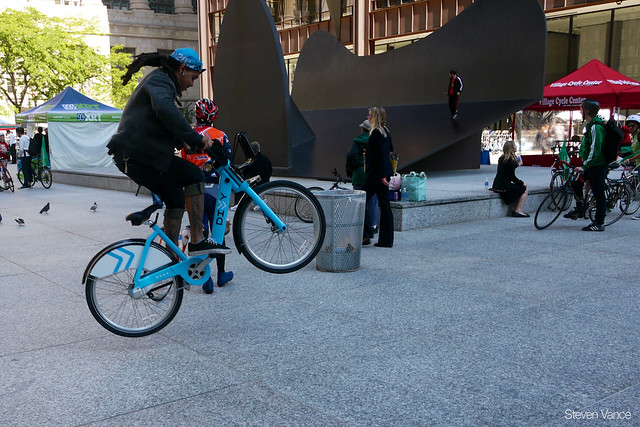
During a recent OpenGov Hack Night, transportation guru Steve Vance demonstrated a simple app that lets you download all the places are people are suggesting new Divvy stations.

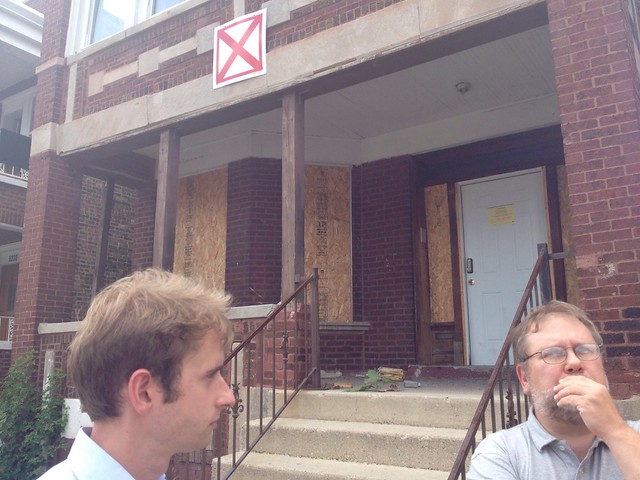
Matt Hampel from LocalData and David McDowell from the Southwest Organizing Project talk about vacant building data.
Smart Chicago Collaborative is proud to announce our partnership with the Southwest Organizing Project and LocalData as part of the Civic Works Project — providing tools that empower organizations to make change in their neighborhoods.
Once again, super-citizen Tom Kompare has come up with a timely, teeny piece of software that helps Chicago residents do important things. Last week, Tom launched www.chicagoflushots.org, a way to find and plan your flu shot this season in Chicago.
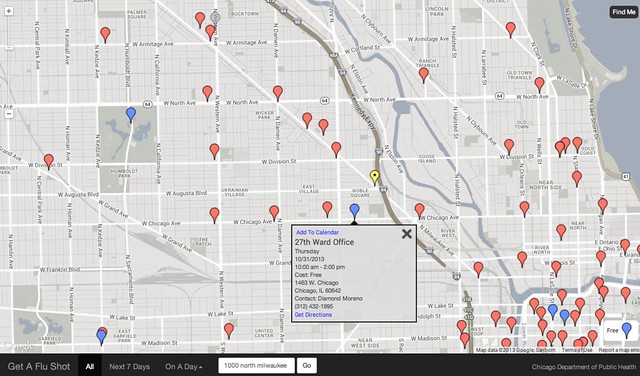
Here’s Tom’s explanation of the site:
Built by Tom Kompare in partnership with the Chicago Department of Public Health (CDPH). This was not developed by CDPH and CDPH makes no representations as to the accuracy of the information provided by this map application. This map application is hosted by the Smart Chicago Collaborative. The code behind this web application is free, open, and under a MIT License. Feel free to send me comments.
Here’s complete information from the City of Chicago, including the current situation in Chicago, why you should get vaccinated, recommendations for treatment if you get the flu, recent news, and other supporting information.
Here’s a snip from an email from CDPH kicking off their flu shot program:
Last month, CDPH announced over 60 special flu vaccination clinics the department is hosting in communities across Chicago through December 14. CDPH also launched an updated version of its online Flu Clinic Finder that pinpoints CDPH clinics by zip code.
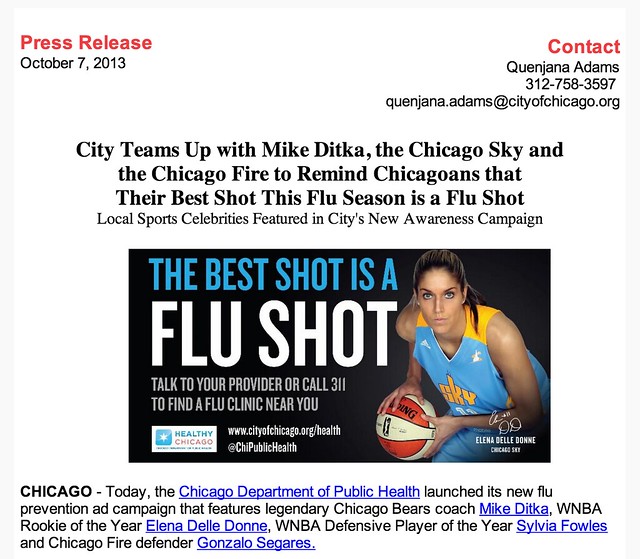
Here’s coverage from ABC 7 News: Health officials: Get your flu shot now.
Smart Chicago is all about providing connective tissue (so to speak) among residents, developers, and government to make lives better in Chicago. Plan your flu shot today.
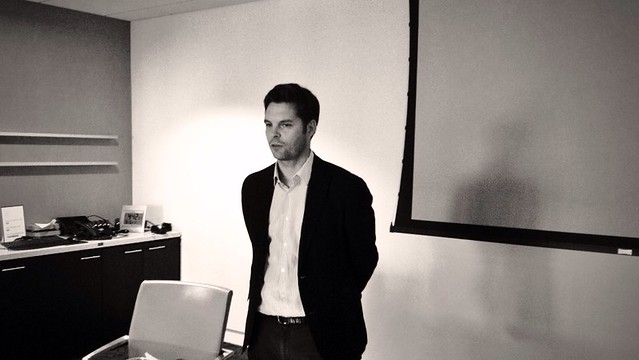
Last week, John Bracken from the John S. and James L. Knight Foundation stopped by the Chicago Community Trust as part of his whirlwind tour of the nation to talk about the latest Knight News Challenge.
It’s August in Chicago, and the attention of parents and kids turn back to school. There are lots of changes this year in the Chicago Public School system, with school closings & consolidations and safe passage routes dominating the news and affecting thousands of families.
At Smart Chicago, we don’t play any part in these matters. But since a large part of our mission is to use technology to make lives better in Chicago, we’ve tried to play a small part in making this transition easier. We host and support an app created by local developer Tom Kompare called Go2School, a website that allows you to explore travel options to your Chicago Public School. He came up for the idea for this site while when trying to figure out the best way to get his daughter to school – either by public transportation, car, or walking.
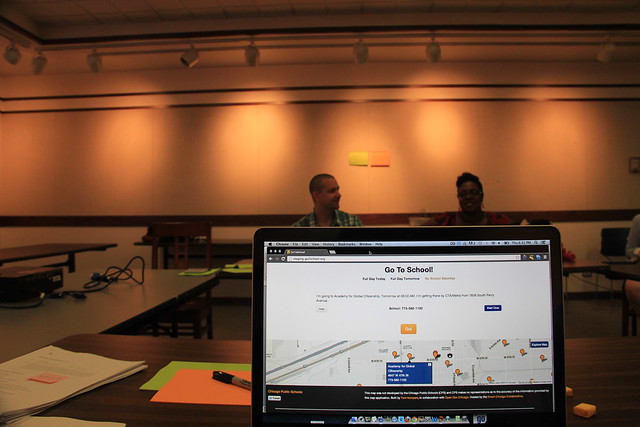
We’ve worked with Tom since the Spring to get server space for his creation, and in late May we tested his app with select members of the CUTGroup, a set of regular Chicago residents who get paid to test civic apps. Following is the results of those test.
In Mid-May we sent two emails to all members of the CUTGroup in order to find the most relevant people with whom to review the site. This complete list of CUTGroup members was 368 people, spread across the city. We segmented on two things:
There were 28 people who responded to these requirements. Based on the locations of these people, we decided to hold tests at two libraries: the Kelly Library in the Englewood neighborhood on Tuesday, May 28th at and at the Uptown Library in the Chicago Uptown neighborhood on Thursday, May 30th. There were 14 people who expressed interested in each location.
We conducted eight tests with people. We discovered at test time that one of the participants did not have a child in a Chicago Public School (his daughter did, but she couldn’t make it to the test, so he attended for her. We ended up having a great conversation with him, but his results are not included here). Here’s a look at the general neighborhood locations of the testers, showing wide geographic distribution:
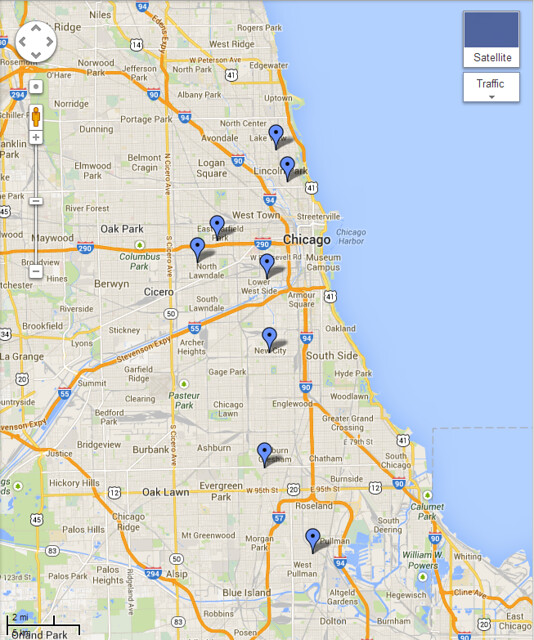
The testers were spot-on knowledgable about the topic of getting kids to school on time. In an effort to maintain privacy and to provide the widest possible utility of our testing to civic developers everywhere, we developed some shorthand “personas” that helps in identifying their stance vis a vis the app. We took some video/ screencasts of the tests. Here are some helpful cuts of the feedback. If you click to view the files on Vimeo, you can jump directly to the area of interest.
CUTGroup #2, Tester #2 Father responsible for three children (17, 16, and 10) Samsung Galaxy Kelly Library, Englewood
CUTGroup #2, Tester #2 Father responsible for three children (17, 16, and 10) Samsung Galaxy Kelly Library, Englewood from Daniel X. O’Neil on Vimeo.
0:04: Trouble with Next Button: After a valid address was entered. Would not accept a click, then it did.
0:54: Second Search: Executed with no problems
1:40: Mindful of danger: Schools and families talked about preferred routes
2:31: Jazzing it up: Would be helpful
CUTGroup #2, Tester #3 Public wifi searcher with one child and sometimes one additional child at another location
CUTGroup #2, Tester #3 Public wifi searcher with one child and sometimes one additional child at another location from Daniel X. O’Neil on Vimeo.
0:04: No broadband at home: Heavy user of public wi-fi
1:10: Homepage map confusing: Because it has nothing to do with where she lives.
1:47: Thought there would be more information about the school: Very much likes having custom school info on the site.
2:38: Her usual route is simple. But sometimes she takes a friend’s child to a different school via a more complex route
3:44: Tries that route: Notwithstanding my instinct to do it for her.
4:00: Starting over was a bit of a challenge: Back button shenanigans and back-space/ deleting the entire length of the pre-populated school name.
4:46: The other school she’s interested in is not a CPS school: “So this is useless to my now”
5:30: But she tries a workaround: With the “Explore Map” link.
6:19: Then she found a bug: Noble Street Charter School was geocoded incorrectly in the original data.
6:41: Back to the workaround: In finding a route to a Catholic school.
7:17: Issue with the time picker: She wants to enter the time she should leave in order to get there on time, rather than entering the time she needs to arrive (which is how the system is designed).
7:40: Then somehow the back button was invoked. Don’t really know how. She recovers and again enters the time she thinks she should leave to be there by 8AM.
8:12: Did not know she had to pick a day. And did not readily see the error condition. Also: still wants to enter *departure* time rather than arrival.
9:58: And now the error re: arrival time becomes evident. And that was a bummer.
10:48: This was an excellent user test. Very grateful.
CUTGroup #2, Tester #5 Clock-watching, train-watching mother of three Samsung Galaxy Note II Uptown Library
CUTGroup #2, Tester #5 Clock-watching, train-watching mother of three Samsung Galaxy Note II Uptown Library from Daniel X. O’Neil on Vimeo.
0:04: Error Correction: Chose the wrong school from list; used delete button to erase entire school name and go back to the pre-populated list, where her child’s school popped up again
0:33: Pressing the delete button: Many times, quickly, so as to go back to the pre-populated form with school names
1:06: Missed the “what day” choice: User did not select what day they were traveling and could not move forward in the interface upon clicking “Next” . She chooses “time to arrive” just fine…
1:19: But then clicks “next” repeatedly: Not seeing that there is an error condition (did not choose a day for travel)
2:30: User does not want to see route on map: Because she is so familiar with it. She wanted validation of her routes and clarity on exactly what time she’d get there, and that’s that. She’s happy.
3:12: “It will really help all the parents know what time they should leave the house” — What this website does
Beyond this super-specific feedback, there were a number of themes worth calling out:
Perhaps the most common of the site’s compliments was the ability to choose which date to leave and which time
Here’s the raw spreadsheet with all of our notes from each of the tests we conducted:
Are you interested in joining 500 of your fellow Chicagoans in the CUTGroup? Do it!
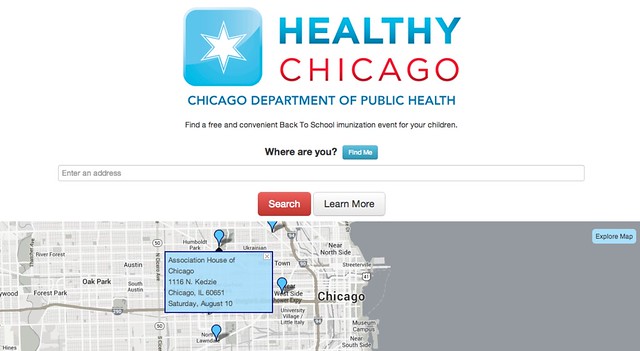
One of the success stories in Chicago’s civic innovation community is the rapid spread of health related apps that have come out of both the volunteer civic technology community and paid development efforts. This started last year with Tom Kompare’s Chicago flu shot app that helped Chicago residents find free flu shots near them. (Later on, this flu shot app spread to Boston and Philadelphia.)
Professionally, Kompare is a web developer with the University of Chicago. In his spare time, he’s one of the most active civic technologists in Chicago.
Kompare’s flu shot app was just the start of the Chicago Department of Public Health partnering up with civic technologists on a number of projects including Foodborne Chicago, the Chicago Health Atlas, and Tom Kompare’s newest app Back to School.
Back to School is an app built for parents to make sure that their child has the immunizations they need to go back to school. CDPH hosts several immunization events for school children throughout the city and the apps helps parents find events near them. This will be also good trial run for the larger immunization effort that CDPH will run this fall.
Not only do these two apps use the same data format, this data format is now a proposed national standard. Shortly after the redeployment of the flu shot app in Philadelphia earlier this year, Philadelphia Chief Data Officer Mark Headd began an effort to develop a national standard for flu shot data. This effort included input from both government officials and civic technologists from Chicago, San Francisco, Austin, Oakland, and other cities. By helping to set up one standard, both of these open source apps are deployable in any city that elects to conform to the standard.
This is not the first app that the Chicago Department of Public Health has partnered with. CDPH also partnered with the Smart Chicago Collaborative to run the Foodborne Chicago app. The app, which was made possible through a variety of efforts, listens to Twitter for reports of food poisoning and then prompts the author to a web page that reports food poisoning to 311. Once it’s reported the 311, the city can then dispatch a health inspector to that location.
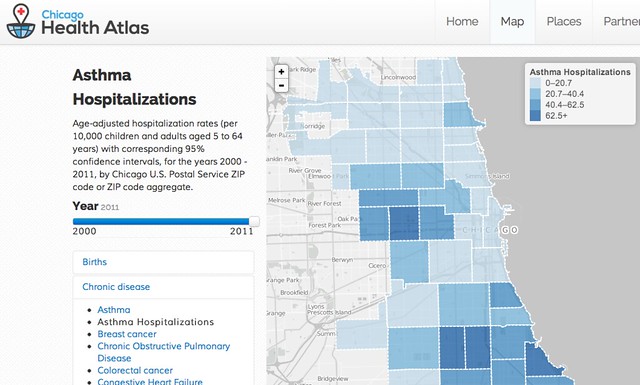
The Chicago Health Atlas, an app that shows health trends and local resources in Chicago, was another app that resulted from community partnerships. Initially, the Atlas was built on an existing partnership by informatics researchers at five major academic health centers in Chicago: University of Illinois at Chicago, Stroger Hospital, University of Chicago, Northwestern University, and Rush University. Since that time, the Chicago Health Atlas has been expanded to include data and researchers from the Chicago Department of Public Health. The site itself was built by Chicago civic app firm Datamade and also uses data from civic startup Purple Binder.
And it’s not just formal partnerships that are producing health related apps. As part of a summer internship program, Chicago Spanish newspaper Vive Lo Hoy hired its first web developer Wilberto Morales. Morales worked with food inspection data provided by the City of Chicago to built eatsafe.co.
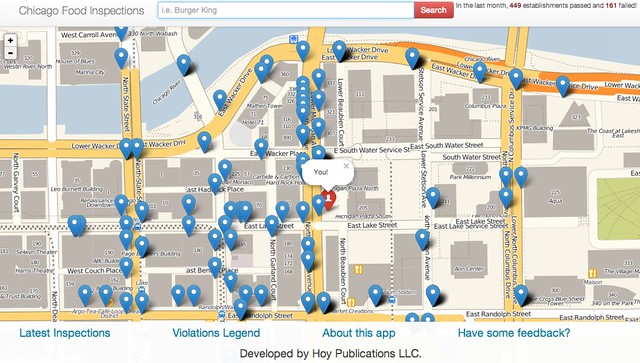
Eatsafe.co helps residents find out how the resturants near them fared during their last food inspection. This open source app includes information on how food inspections in Chicago work. (Unlike some other cities, Chicago’s system is pass-fail and not by letter grade.) This is Hoy’s first app and they plan to continue building more apps to help address community issues.
Morales learned to code, not from a formal computer science program, but by being a part of FreeGeek Chicago’s Supreme Chi-Town Coding Crew. FreeGeek Chicago, a Humboldt Park non-profit organization, helps the community by recycling and repairing old electronics. FreeGeek trains volunteers on computer repair techniques and offers the opportunity for residents to earn a refurbished computer through their Earn-A-Box Program. In March, FreeGeek’ Chicago’s members decided to launch a program to teach residents how to develop web applications. It’s certainly been a big success, as evidenced by the Supreme Chi-Town Coding Crew winning the Chicago Migrahack with their app Finding Care.
So why is Chicago producing so many high quality health apps so quickly?
Data is fuel. None of these applications would be possible without the City of Chicago developing an open data policy and executing on it. Chicago has more data sets than any other city. Their deep involvement with the civic technology community allows the city’s data team to meet the needs of civic innovators creating apps that serve the community.
The Chicago OpenGov Hack nights attract some of the city’s best geeks to work at the intersection of technology and civic problems. However, if the hack nights and other civic innovation efforts only attract web developers, designers, and data gurus we end up missing a vital piece of the puzzle: the neighbor that we’re trying to help.
By partnering with city departments, non-profit organizations, and community organizers – the community is able to develop apps centered around the civic problem in a way that helps the people who are working in the trenches. Both volunteer efforts like OpenGov Chicago and the Smart Chicago Collaborative are continuing to do outreach with civic organizations to help foster partnerships between technologists and community activists.
The civic innovation community is growing – but not nearly fast enough. To meet the challenges brought on by the Great Recession, we need more people with technology skills necessary to grow the civic technology space. Efforts by FreeGeek Chicago and the Englewood Codes project by Teamwork Englewood are helping to create more technologists in the city’s neighborhoods.
Lastly, it’s important that the civic innovation community solve real problems that matter to real people. Part of the side effect of having strong partnerships in both government and the neighborhoods is the learning what is happening on the front lines of civic work. The Back to School app came about as a result of Tom overhearing a conversation about CDPH’s back to school campaign while working on the update for the flu shot app. Having civic technologists listening to not only tech issues, but issues like education results in web app like schoolcuts.org being created.
Building civic apps is more than just the code – the real secret to success is community.